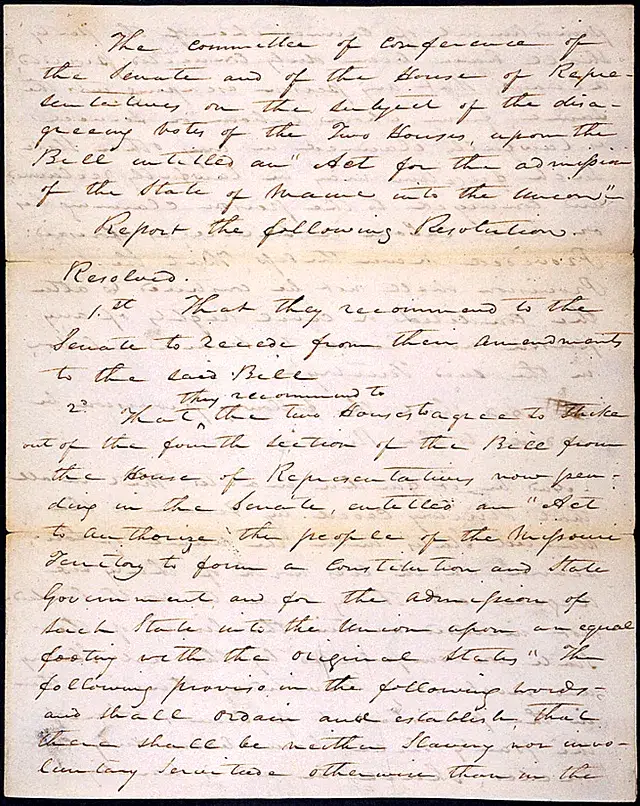Missouri Compromise
The Missouri Compromise of 1820: A Historic Balancing Act
Passed on March 3, 1820, the Missouri Compromise was a pivotal piece of legislation aimed at easing the escalating tensions over slavery in the United States. This landmark compromise was designed to maintain the delicate balance of power between Northern and Southern states.

[su_box title=”Missouri Compromise : Next years” box_color=”#fb0400″]
- Monday, 3 March 2025
- Tuesday, 03 March 2026
- Wednesday, 03 March 2027
- Friday, 03 March 2028
[/su_box]
Key Provisions of the Missouri Compromise
The Missouri Compromise admitted Maine as a free state and Missouri as a slave state. This measure was crucial in preserving the balance of power in the Senate, where an equal number of free and slave states would prevent any single region from dominating.
Additionally, the Compromise established the 36º 30′ parallel as the boundary line, prohibiting slavery in all new territories north of this latitude, with the exception of Missouri. This provision held until the Compromise was repealed in 1854.
Background and Context
The issue began when Missouri applied for statehood in 1818, seeking to permit slavery. As the first state west of the Mississippi River, Missouri’s decision to allow slavery intensified the national debate on the issue. Northerners, primarily abolitionists, feared that admitting Missouri as a slave state would disrupt the balance between free and slave states. Conversely, Southerners advocated for the right of new states to decide on slavery themselves.
In early 1819, Northern Representative James Tallmadge proposed amendments to restrict slavery in Missouri, which Southern representatives opposed. The Senate, evenly split between free and slave states, faced a critical impasse. To resolve this, Speaker of the House Henry Clay proposed admitting Missouri as a slave state if Maine were admitted as a free state.
In February 1820, the Compromise was formalized, with a bill that admitted Maine and Missouri under the agreed terms. President James Monroe signed the bill into law on March 6, 1820.
Repeal and Legacy
Despite temporarily resolving the slavery issue, the Missouri Compromise did not settle the broader debate over slavery’s future in the United States. The Westward Expansion continued to fuel tensions, leading to the Kansas-Nebraska Act of 1854, which effectively repealed the Missouri Compromise by allowing settlers in new territories to decide on the legality of slavery. This shift led to significant controversy, violent conflicts, and the rise of the Republican Party with Abraham Lincoln.
The Dred Scott v. Sandford Supreme Court case in 1857 further invalidated the Missouri Compromise, ruling that Congress had no authority to prohibit slavery in any state. This decision was a key factor leading to the American Civil War.
Interesting Facts
- Henry Clay, known as “The Great Compromiser,” played a significant role in brokering the Missouri Compromise.
- The Compromise was declared unconstitutional in the Dred Scott case.
- Supporters of slavery in Congress were termed “anti-restrictionists,” while opponents were known as “restrictionists.”
- The Kansas-Nebraska Act of 1854 nullified the 36º 30′ line established by the Missouri Compromise.
The Missouri Compromise remains a crucial chapter in American history, reflecting the complex and contentious nature of slavery and its impact on the nation’s development.


